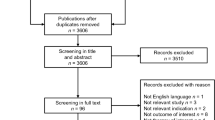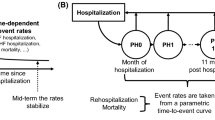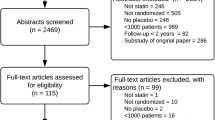Abstract
Background
Clinical trials often report intervention efficacy in terms of the reduction in all-cause mortality between the treatment and control arms (i.e., an overall hazard ratio [oHR]) instead of the reduction in disease-specific mortality (i.e., a disease-specific hazard ratio [dsHR]). Using oHR to reduce all-cause mortality beyond the time horizon of the trial may introduce bias if the relative proportion of other-cause mortality increases with age. We sought to quantify this oHR extrapolation bias and propose a new approach to overcome this bias.
Methods
We simulated a hypothetical cohort of patients with a generic disease that increased background mortality by a constant additive disease-specific rate. We quantified the bias in terms of the percentage change in life expectancy gains with the intervention under an oHR compared with a dsHR approach as a function of the cohort start age, the disease-specific mortality rate, dsHR, and the duration of the intervention’s effect. We then quantified the bias in a cost-effectiveness analysis (CEA) of implantable cardioverter-defibrillators based on efficacy estimates from a clinical trial.
Results
For a cohort of 50-year-old patients with a disease-specific mortality of 0.05, a dsHR of 0.5, a calculated oHR of 0.55, and a lifetime duration of effect, the bias was 28%. We varied these key parameters over wide ranges and the resulting bias ranged between 3 and 140%. In the CEA, the use of oHR as the intervention’s effectiveness overestimated quality-adjusted life expectancy by 9% and costs by 3%, biasing the incremental cost-effectiveness ratio by − 6%.
Conclusions
The use of an oHR approach to model the intervention’s effectiveness beyond the time horizon of the trial overestimates its benefits. In CEAs, this bias could decrease the cost of a QALY, overestimating interventions’ cost effectiveness.





Similar content being viewed by others
References
Kuntz KM, Russell LB, Owens DK, Sanders GD, Trikalinos TA, Salomon JA. Decision models in cost-effectiveness analysis. In: Neumann PJ, Sanders GD, Russell LB, Siegel JE, Ganiats TG, editors. Cost-effectiveness Heal Med. Second. New York: Oxford University Press; 2017. p. 105–36.
Kuntz KM, Weinstein MC. Life expectancy biases in clinical decision modeling. Med Decis Mak. 1995;15:158–69.
Bentley TGK, Weinstein MC, Kuntz KM. Effects of categorizing continuous variables in decision-analytic models. Med Decis Mak. 2009;29:549–56.
Bentley TGK, Kuntz KM, Ringel JS. Bias associated with failing to incorporate dependence on event history in Markov models. Med Decis Mak. 2010;30:651–60.
Goldie SJ, Kuntz KM. A potential error in evaluating cancer screening: a comparison of 2 approaches for modeling unerlying disease progression. Med Decis Mak. 2010;23:232–41.
Gold MR, Siegel JE, Russell LB, Weinstein MC. Cost-effectiveness in health and medicine. New York: Oxford University Press; 1996.
Weinstein MC, O’Brien B, Hornberger J, Jackson J, Johannesson M, McCabe C, et al. Principles of good practice for decision analytic modeling in health-care evaluation: report of the ISPOR Task Force on Good Research Practices-Modeling Studies. Value Health. 2003;6:9–17.
National Institute for Health and Care Excellence. Guide to the methods of technology appraisal 2013 [Internet]. London, UK; 2013. p. 1–93. Available from: http://www.nice.org.uk/article/pmg9/resources/non-guidance-guide-to-the-methods-of-technology-appraisal-2013-pdf.
Blagoev KB, Wilkerson J, Fojo T. Hazard ratios in cancer clinical trials—a primer. Nat Rev Clin Oncol. 2012;9:178–83.
Cox DR. Models and life-tables regression. J R Stat Soc. 1972;34:187–220.
Spruance SL, Reid JE, Grace M, Samore M. Hazard ratio in clinical trials. Antimicrob Agents Chemother. 2004;48:2787–92.
Ramsey SD, Willke R, Briggs AH, Brown RE, Buxton M, Chawla A, et al. Good research practices for cost-effectiveness analysis alongside clinical trials: the ISPOR RCT-CEA Task Force Report. Value Health. 2005;8:521–33.
Ramsey SD, Willke RJ, Glick H, Reed SD, Augustovski F, Jonsson B, et al. Cost-effectiveness analysis alongside clinical trials II—an ISPOR Good Research Practices Task Force Report. Value Health. 2015;18:161–72.
Neumann PJ, Sanders GD, Russell LB, Siegel JE, Ganiats TG, editors. Cost-effectiveness in health and medicine. Second. New York: Oxford University Press, Incorporated; 2017.
Briggs A, Sculpher M, Claxton K. Decision modelling for health economic evaluation. New York: Oxford University Press; 2006.
Canadian Agency for Drugs and Technologies in Health (CADTH). Guidelines for the Economic Evaluation of Health Technologies. 3rd ed. 2006.
Latimer NR. Survival analysis for economic evaluations alongside clinical trials–extrapolation with patient-level data: Inconsistencies, limitations, and a practical guide. Med Decis Mak. 2013;33:743–54.
Caro JJ, Briggs AH, Siebert U, Kuntz KM. Modeling good research practices—overview: a report of the ISPOR-SMDM Modeling Good Research Practices Task Force-1. Med Decis Mak. 2012;32:667–77.
Drummond MF, Sculpher MJ, Torrance GW, O’Brien BJ, Stoddart GL. Methods for the economic evaluation of health care programmes. 3rd ed. New York: Oxford University Press; 2005.
O’Brien B. Economic evaluation of pharmaceuticals: Frankenstein’s monster or vampire of trials? Med Care. 1996;34(12 Suppl):DS99–108.
Benaglia T, Jackson CH, Sharples LD. Survival extrapolation in the presence of cause specific hazards. Stat Med. 2014;34:796–811.
Jackson C, Stevens J, Ren S, Latimer N, Bojke L, Manca A, et al. Extrapolating survival from randomized trials using external data: a review of methods. Med Decis Mak. 2017;37:377–90.
Williams C, Lewsey JD, Briggs AH, Mackay DF. Estimation of survival probabilities for use in cost-effectiveness analysis: a comparison of a multi-state modelling survival analysis approach with partitioned survival and Markov decision-analytic modelling. Med Decis Mak. 2017;37:427–39.
Kuntz KM, Weinstein MC. Modelling in economic evaluation. In: Drummond MF, McGuire A, editors. Econ eval heal care merging theory with pract. 2nd ed. New York: Oxford University Press; 2001. p. 141–71.
Arias E. United States Life Tables, 2009. Nat Vital Stat Rep. 2014;62(7):1–63.
Kuntz KM, Goldie SJ. Assessing the sensitivity of decision-analytic results to unobserved markers of risk: defining the effects of heterogeneity bias. Med Decis Mak. 2002;22:218–27.
Sonnenberg FA, Beck JR. Markov models in medical decision making: a practical guide. Med Decis Mak. 1993;13:322–38.
Beck JR, Pauker SG. The Markov process in medical prognosis. Med Decis Mak. 1983;3:419–58.
Harwell M, Kohli N, Peralta Y. Experimental design and data analysis in computer simulation studies in the behavioral sciences. J Mod Appl Stat Methods. 2017;16:3–28.
Morris TP, White IR, Crowther MJ. Using simulation studies to evaluate statistical methods. Stat Med. 2019;38:2074–102.
Mirowski M, Reid PR, Mower MM, Watkins L, Gott VL, Schauble JF, et al. Termination of malignant ventricular arrhythmias with an implanted automatic defibrillator in human beings. N Engl J Med. 1980;303:322–4.
Moss AJ, Zareba W, Hall WJ, Klein H, Wilber DJ, Cannom DS, et al. Prophylactic implantation of a defibrillator in patients with myocardial infarction and reduced ejection fraction. N Engl J Med. 2002;346:877–83.
Sanders GD, Hlatky MA, Owens DK. Cost-effectiveness of implantable cardioverter-defibrillators. N Engl J Med. 2005;353:1471–80.
Technology Evaluation Center. Special report: cost-effectiveness of implantable cardioverter-defibrillators in a MADIT-II population. Assess Progr. 2004;19:1–2.
Fryback DG, Dasbach EJ, Klein R, Klein BE, Dorn N, Peterson K, et al. The Beaver Dam Health Outcomes Study: initial catalog of health-state quality factors. Med Decis Mak. 1993;13:89–102.
Owens DK, Sanders GD, Harris RA, McDonald KM, Heidenreich PA, Dembitzer AD, et al. Cost-effectiveness of implantable cardioverter defibrillators relative to amiodarone for prevention of sudden cardiac death. Ann Intern Med. 1997;126:1–12.
O’Brien BJ, Connolly SJ, Goeree R, Blackhouse G, Willan A, Yee R, et al. Cost-effectiveness of the implantable cardioverter-defibrillator: results from the Canadian Implantable Defibrillator Study (CIDS). Circulation. 2001;103:1416–21.
Jalal H, Pechlivanoglou P, Krijkamp E, Alarid-Escudero F, Enns EA, Hunink MGM. An overview of R in health decision sciences. Med Decis Mak. 2017;37:735–46.
Sanders GD, Owens DK, Hlatky MA. Potential cost-effectiveness of wearable cardioverter-defibrillator early post myocardial infarction. Innov Card Rhythm Manag. 2015;6:1929–40.
Theuns DAMJ, Smith T, Hunink MGM, Bardy GH, Jordaens L. Effectiveness of prophylactic implantation of cardioverter-defibrillators without cardiac resynchronization therapy in patients with ischaemic or non-ischaemic heart disease: a systematic review and meta-analysis. Europace. 2010;12:1564–70.
Smith T, Jordaens L, Theuns DAMJ, Van Dessel PF, Wilde AA, Myriam Hunink MG. The cost-effectiveness of primary prophylactic implantable defibrillator therapy in patients with ischaemic or non-ischaemic heart disease: a European analysis. Eur Heart J. 2013;34:211–9.
Author information
Authors and Affiliations
Contributions
FA-E and KMK: study design and analysis. All authors participated in the interpretation of the data, drafting of the manuscript, critical revision of the manuscript, and approval of the final manuscript.
Corresponding author
Ethics declarations
Funding/support
Dr Alarid-Escudero was supported by a grant from Fulbright-García Robles and the National Council of Science and Technology of Mexico (CONACYT) as part of Dr Alarid-Escudero’s doctoral program. Drs Kuntz and Alarid-Escudero were supported by a grant from the National Cancer Institute (U01-CA-199335) as part of the Cancer Intervention and Surveillance Modeling Network (CISNET). The content is solely the responsibility of the authors and does not necessarily represent the official views of the National Institutes of Health. The funding agencies had no role in the design of the study, interpretation of results, or writing of the manuscript. The funding agreement ensured the authors’ independence in designing the study, interpreting the data, writing, and publishing the report.
Conflict of interest
FA-E reports no conflicts of interest. KMK reports no conflicts of interest.
Data availability statement
Data and statistical code are provided in the dsHR R package hosted in the GitHub repository https://github.com/feralaes/dshr. The version of dsHR released in this article is available at https://doi.org/10.5281/zenodo.3546663.
Electronic supplementary material
Below is the link to the electronic supplementary material.
Rights and permissions
About this article
Cite this article
Alarid-Escudero, F., Kuntz, K.M. Potential Bias Associated with Modeling the Effectiveness of Healthcare Interventions in Reducing Mortality Using an Overall Hazard Ratio. PharmacoEconomics 38, 285–296 (2020). https://doi.org/10.1007/s40273-019-00859-5
Published:
Issue Date:
DOI: https://doi.org/10.1007/s40273-019-00859-5




